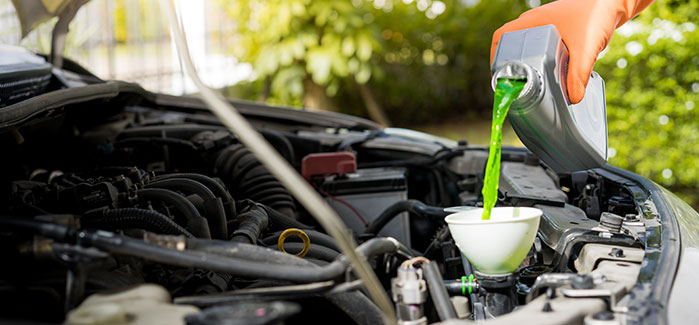As the source of power for cars, engines get extremely hot. Without proper protection, an engine can wear down and even melt, which can cost thousands of dollars to replace.
Car coolant, also known as antifreeze coolant, protects engines from overheating. Coolant also lubricates the moving parts it comes into contact with, which protects damage to the water pump, head gasket, the cylinder and piston timing.
Omar Ramirez, Universal Technical Institute’s (UTI) Education and Development, Curriculum Content Developer, talks about types of car coolant and what happens if you run out of coolant. Omar learned about car coolant as a UTI student himself. Now he’s helping current students master the details of this essential auto component.
What Does Engine Coolant Do?
Wondering what is car coolant exactly? Coolant transfers heat and adds antifreeze protection to an engine, so your car can stay running in optimal condition.
Internal combustion engines create energy by burning fuel. Part of this energy is harnessed by the engine and is used to move the vehicle forward. The remaining energy is converted into heat.
A portion of this heat leaves the engine through the exhaust. The rest remains in the engine block itself.
Average combustion temperatures are close to 2,000°F and, in some instances, may reach as high as 4,500°F. Aluminum components melt at about 1,225°F.
A considerable amount of engine failures are related in some way to engine cooling problems. To protect the engine and to keep it running at the ideal temperature, engine coolant is used.
How Does Engine Coolant Work?
Car coolant is located in a reservoir affixed to the radiator before it’s introduced to the engine block and its components.
Engine coolant is used in conjunction with a liquid cooling system. The liquid cooling system is made up of several components.
The water pump, or coolant pump, circulates coolant throughout the system.
The radiator conducts heat away from the coolant.
Radiator hoses connect the parts of the cooling system.
The fan pulls air through the radiator when the vehicle is not moving fast enough to move the air.
The thermostat controls the temperature of the coolant.
When the engine’s running, the coolant continuously circulates through the engine and back through the radiator. Coolant exits from the bottom of the radiator after it’s cooled. It’s then drawn into the water pump, which pumps it into the engine’s block and head, where it absorbs the excess heat to control the engine temperature. The coolant is then returned to the top of the radiator where it’s cooled again.

